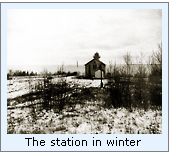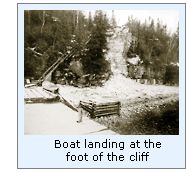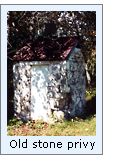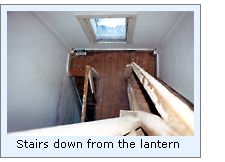|
Historical
Information

French voyageurs experiencing violent seas in the passage between
the peninsula and Washington, Island named the passage Porte des
Mort" which translates as "Door of the Dead." When
deciding on a name for a new county to include the entire peninsula in
1851, the Wisconsin Legislature decided to drop the latter part of the
name, and settled on Door County.
 With growing trade between Green Bay
and the cities of the eastern Great Lakes in the early 1830's, vessel
traffic through the Porte des Mort passage increased dramatically, and
with no navigational aids in the Port Des Mort area, the need for a
lighthouse marking the passage became increasingly important. In 1834,
thirty Detroit merchants and ship owners petitioned Congress to build a
lighthouse on Rock Island to guide their vessels through the Rock Island
Passage. With growing trade between Green Bay
and the cities of the eastern Great Lakes in the early 1830's, vessel
traffic through the Porte des Mort passage increased dramatically, and
with no navigational aids in the Port Des Mort area, the need for a
lighthouse marking the passage became increasingly important. In 1834,
thirty Detroit merchants and ship owners petitioned Congress to build a
lighthouse on Rock Island to guide their vessels through the Rock Island
Passage.
Responding to the request, Congress
appropriated the sum of $8000.00 for the project, and title was attained
to a 134-acre parcel of land on the island, including a section of bluff
137 feet above the lake on which to build the structure.
 Plans for the tower and detached
keepers dwelling were drawn-up, and work began on the island in April of
1836. The keeper's native stone one and a half story keepers dwelling
was only thirty-four feet by twenty feet in size. However, with only one
keeper planned to man the station provided sufficient living space for
living and the storage of the supplies needed to last between supply
deliveries. The thirty-foot stone tall stone tower was eighteen feet in
diameter at its base, tapering to nine feet in diameter at the top. The
eleven foot diameter lantern gallery deck was capped with an octagonal
iron lantern room, and housed an eleven lamp Winslow
Lewis array with fourteen
inch reflectors. Situated as it was on the bluff above the island, the
light boasted a 159-foot focal plane. Plans for the tower and detached
keepers dwelling were drawn-up, and work began on the island in April of
1836. The keeper's native stone one and a half story keepers dwelling
was only thirty-four feet by twenty feet in size. However, with only one
keeper planned to man the station provided sufficient living space for
living and the storage of the supplies needed to last between supply
deliveries. The thirty-foot stone tall stone tower was eighteen feet in
diameter at its base, tapering to nine feet in diameter at the top. The
eleven foot diameter lantern gallery deck was capped with an octagonal
iron lantern room, and housed an eleven lamp Winslow
Lewis array with fourteen
inch reflectors. Situated as it was on the bluff above the island, the
light boasted a 159-foot focal plane.
David E. Corbin, a veteran of the 1812
War and a former employee of the American Fur Company was selected as
the station's first keeper, and Corbin exhibited the light for the first
time in October of 1837. With the illumination of the Pottawatomie light
a number of "firsts" were established, as the lighthouse was
the first in Wisconsin, the first on Lake Michigan, and Corbin was by
definition the first keeper for both.
 Corbin's had his work cut out for him,
as he had to cut a mile-long trail from the light to the boat landing at
the south end of the island. All supplies for the station, including
fuel, food and drinking water had to be carried along this trail. During
one of the infamous surprise lighthouse inspections in 1845 the District
Inspector found that while Corbin stewardship of the light was
efficient, he found Corbin extremely lonely and sullen. Instructing
Corbin to find a wife, the Inspector gave him a twenty-day leave to find
a marriage partner. While Corbin took the leave, he was unsuccessful in
his quest, and continued to man the light in isolation, save for the
companionship of his dog and horse. In December 1852, Corbin died alone
on the island, and was buried in a small graveyard to the south of the
light station that he faithfully manned for fifteen years. Corbin's had his work cut out for him,
as he had to cut a mile-long trail from the light to the boat landing at
the south end of the island. All supplies for the station, including
fuel, food and drinking water had to be carried along this trail. During
one of the infamous surprise lighthouse inspections in 1845 the District
Inspector found that while Corbin stewardship of the light was
efficient, he found Corbin extremely lonely and sullen. Instructing
Corbin to find a wife, the Inspector gave him a twenty-day leave to find
a marriage partner. While Corbin took the leave, he was unsuccessful in
his quest, and continued to man the light in isolation, save for the
companionship of his dog and horse. In December 1852, Corbin died alone
on the island, and was buried in a small graveyard to the south of the
light station that he faithfully manned for fifteen years.
 Over the ensuing years, it was plain
that the mortar used in the construction of the station was of an
inferior constituency, and as a result continuing moisture damage was
found to be compromising the structural integrity of the buildings. By
the early 1850's, determining that the station was close to collapse,
the Lighthouse Board decided that it would be more cost effective to
demolish the structure and rebuild than to undergo repairs. Over the ensuing years, it was plain
that the mortar used in the construction of the station was of an
inferior constituency, and as a result continuing moisture damage was
found to be compromising the structural integrity of the buildings. By
the early 1850's, determining that the station was close to collapse,
the Lighthouse Board decided that it would be more cost effective to
demolish the structure and rebuild than to undergo repairs.
In 1858, a construction crew and
supplies were once again dropped-off at Rock Island, and the original
tower and dwelling were razed. In its place rose the existing two story
30' by 31' native limestone dwelling with a full walkout cellar. Designed as a
duplex, the Head keeper had the use of the first floor, and his
assistant the second floor. Featuring an integral light tower centrally
located at the north end of its' roof, the tower was capped with a
nonagonal iron lantern room, and outfitted with a new Fourth Order
Fresnel lens. The tower's 137-foot focal plane allowed the stations new
fixed white light to be seen from a distance of almost eighteen miles on
clear nights.
 The grounds around the station were
cleared by the keepers to provide firewood wood and an area in which to
grow vegetables for food to augment the annual supply visit of the
lighthouse tenders. Apple trees and lilac bushes were planted, and
families used a hand pump in the kitchen to pump water from a cistern in
the basement into which runoff from the roof was channeled and stored. The grounds around the station were
cleared by the keepers to provide firewood wood and an area in which to
grow vegetables for food to augment the annual supply visit of the
lighthouse tenders. Apple trees and lilac bushes were planted, and
families used a hand pump in the kitchen to pump water from a cistern in
the basement into which runoff from the roof was channeled and stored.
 Emily Betts also served as an assistant
keeper under her husband William Betts from 1872 to 1882. Two of the
Betts's nine children were born in the lighthouse. Not only did Emily
Betts have her daily lighthouse duties, she also taught school in the
basement of the keeper's quarters, nursed the sick on the island, and
brought several babies into the world, including a pair of twins. Emily Betts also served as an assistant
keeper under her husband William Betts from 1872 to 1882. Two of the
Betts's nine children were born in the lighthouse. Not only did Emily
Betts have her daily lighthouse duties, she also taught school in the
basement of the keeper's quarters, nursed the sick on the island, and
brought several babies into the world, including a pair of twins.
The year after assuming responsibility
for the Nation's lighthouses, the Coast Guard dispatched a crew to Rock
Island to automate the light with a battery-powered flashing light
within the Fresnel lens in 1946, and the station's last two keepers
Butters and Ernest Lockhart left the island for the final time.
 In 1986, solar panels were installed,
and the Fresnel was crated-up, removed from the tower, and stored in the
station basement. Finally in 1988, with the assistance of a Coast Guard
helicopter, a new steel tower was erected on the site, and
Pottawatomie's light was permanently extinguished. At this time, it was
also determined that condensation from poor ventilation within the
lantern room was causing the lantern to decay from the inside out.
Fearing that it may crumble and fall in some future storm, the lantern
room was demolished, and the tower capped-off to prevent water seepage
into the tower. In 1986, solar panels were installed,
and the Fresnel was crated-up, removed from the tower, and stored in the
station basement. Finally in 1988, with the assistance of a Coast Guard
helicopter, a new steel tower was erected on the site, and
Pottawatomie's light was permanently extinguished. At this time, it was
also determined that condensation from poor ventilation within the
lantern room was causing the lantern to decay from the inside out.
Fearing that it may crumble and fall in some future storm, the lantern
room was demolished, and the tower capped-off to prevent water seepage
into the tower.
In 1994, the Friends of Rock Island was
formed to aid the Department of Natural Resources in improve the beauty
and historic significance of the island State Park. As part of this
enhancement, the decision was made to restore the lighthouse and
reconstruct the missing lantern room.
 With only the original cast iron
windowsills remaining in the cellar to use in creating a pattern, other
lighthouses with nonagonal lantern rooms contemporary with the station
were visited, and plans for the new lantern room were drawn-up by Tony
Hodges, of Sturgeon Bay. With approval of the plans, and the assistance
of his son, Hodges began work on the new lantern room in his Sturgeon
Bay shop. In June of 1999, the finished lantern room was disassembled,
the components transported to Washington Island, and carried to Rock
Island by boat. Carried to the lighthouse on the park pickup truck, the
components were hoisted to the top of the tower through the use of a
jerry-rigged crane fashioned from an aluminum extension ladder and a
battery powered winch. With only the original cast iron
windowsills remaining in the cellar to use in creating a pattern, other
lighthouses with nonagonal lantern rooms contemporary with the station
were visited, and plans for the new lantern room were drawn-up by Tony
Hodges, of Sturgeon Bay. With approval of the plans, and the assistance
of his son, Hodges began work on the new lantern room in his Sturgeon
Bay shop. In June of 1999, the finished lantern room was disassembled,
the components transported to Washington Island, and carried to Rock
Island by boat. Carried to the lighthouse on the park pickup truck, the
components were hoisted to the top of the tower through the use of a
jerry-rigged crane fashioned from an aluminum extension ladder and a
battery powered winch.
The Friends of Rock Island have plans
to undertake a complete restoration of the station and grounds to their
original historical condition by 2002. The plans include interior
plasterwork woodwork and painting, and restoration of the outhouse, oil
house and nearby smokehouse.
In all, as a result of the caring of
the Friends of Rock Island and the Department of Natural Resources, the
future looks bright for this historical structure.

Keepers of this
Light

Click Here to see a complete listing of all
Pottawatomie Light keepers compiled by Phyllis L. Tag of Great Lakes
Lighthouse Research.

Seeing this
Light

Rock Island is about as difficult a place to visit as any location in
Wisconsin, and a whole day is required to make the trip.
Take Highway 42 north
through the Door Peninsula to its end at the Northport Ferry pier.
Book passage and drive your vehicle onto the Washington Island Ferry
Line's car ferry "Robert Noble" for the thirty minute crossing
to Washington Island. Note that distant views
of Pilot, Plum and Detroit Islands can be seen while making the
crossing.
On arrival et the ferry
dock on Washington Island, drive north on Lobdell Point Road until the
road becomes Main Road. Take Main Road north to the point at which
Jackson Harbor Road Tees to the right. Turn onto Jackson Harbor Road,
and follow the road east into Jackson Harbor. Keep heading straight
until you reach the Rock Island Ferry dock, and park your vehicle.
The Ferry which makes
the crossing to Rock Island is a passenger ferry only, as no
vehicles of any kind are allowed on Rock Island. Book passage, and board
the 36 foot ferry boat "Karfi" for the 15 minute trip to Rock
Island. Once arriving on Rock Island, walk north about a block to a
stone building on the hill. Follow the trail behind this building to a
timber arch. Follow the mile-long trail up the hill. When
encountering any branches in the trail along the way, always take the
left branch, staying atop the bluff to the lighthouse.
The Washington Island
Ferry Line has a website
featuring current schedule and fare information, and general information
concerning Washington Island itself. They can also be contacted by
telephone at (800) 223-2094.
While the Rock Island
"KARFI" Ferry is also operated by the Washington Island Ferry Line, there is
currently no information about the ferry's schedule on the website. We
would suggest that you contact them directly for information.

Reference Sources

Inventory
of Historic Light Stations, National Parks Service, 1994
Annual reports of the Lighthouse Board, 1853 - 1909
Rock Island's Lighthouse, Voyageur Magazine, Tim Sweet,
Summer/Fall 2000,
Email from Tom Tag on spelling of station name, 8/10/2000.
Door County Maritime Museum, Pottawatomie page, website
Lighthouse Digest, May & October 1999 issues
Wisconsin Natural Resources, February, 2000
Wisconsin Handbook, Thomas Huhti, 1997
Personal observation at Rock Island, 09/12/2000.
Keeper listings for this light appear courtesy of Great
Lakes Lighthouse Research
|





